Independent Living: Technology Support Report - Health and Social Care
VerifiedAdded on 2020/06/03
|11
|4105
|106
Report
AI Summary
This report delves into the application of technology to facilitate independent living, particularly within the context of health and social care. It begins with an introduction to the concept of independent living and highlights the importance of assistive technologies, such as handheld personal digital assistants (PDAs) and pocket coaches, in supporting individuals with specific needs, such as those with multiple sclerosis, blurred vision and mobility issues. The report then examines the barriers to the adoption of such technologies, including suitability concerns, limitations in addressing severe conditions, and potential for malfunctioning. It further details the benefits for both service users and organizations, including improved quality of life, cost-effectiveness, and enhanced management of patient care. The report also covers health and safety considerations, emphasizing the need for reliable and secure technologies, alongside ethical issues such as patient autonomy, confidentiality, and the impact of technological advancements on care delivery. The report concludes by offering recommendations for technology use to support independent living, addressing the specific needs of individuals requiring assistance. The report includes references to support the claims and analysis presented.

Supporting
Independent Living
Independent Living
Paraphrase This Document
Need a fresh take? Get an instant paraphrase of this document with our AI Paraphraser
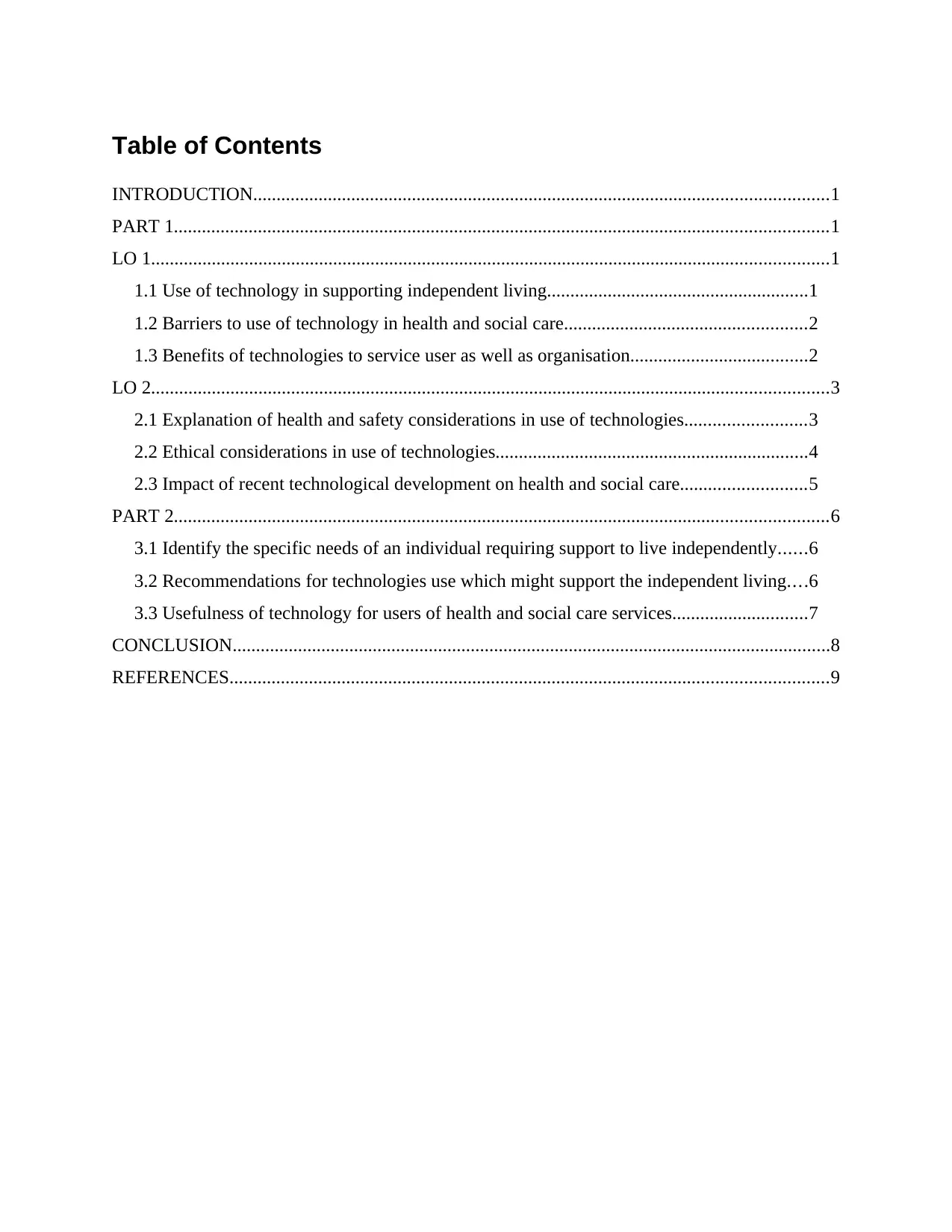
Table of Contents
INTRODUCTION...........................................................................................................................1
PART 1............................................................................................................................................1
LO 1.................................................................................................................................................1
1.1 Use of technology in supporting independent living........................................................1
1.2 Barriers to use of technology in health and social care....................................................2
1.3 Benefits of technologies to service user as well as organisation......................................2
LO 2.................................................................................................................................................3
2.1 Explanation of health and safety considerations in use of technologies..........................3
2.2 Ethical considerations in use of technologies...................................................................4
2.3 Impact of recent technological development on health and social care...........................5
PART 2............................................................................................................................................6
3.1 Identify the specific needs of an individual requiring support to live independently......6
3.2 Recommendations for technologies use which might support the independent living....6
3.3 Usefulness of technology for users of health and social care services.............................7
CONCLUSION................................................................................................................................8
REFERENCES................................................................................................................................9
INTRODUCTION...........................................................................................................................1
PART 1............................................................................................................................................1
LO 1.................................................................................................................................................1
1.1 Use of technology in supporting independent living........................................................1
1.2 Barriers to use of technology in health and social care....................................................2
1.3 Benefits of technologies to service user as well as organisation......................................2
LO 2.................................................................................................................................................3
2.1 Explanation of health and safety considerations in use of technologies..........................3
2.2 Ethical considerations in use of technologies...................................................................4
2.3 Impact of recent technological development on health and social care...........................5
PART 2............................................................................................................................................6
3.1 Identify the specific needs of an individual requiring support to live independently......6
3.2 Recommendations for technologies use which might support the independent living....6
3.3 Usefulness of technology for users of health and social care services.............................7
CONCLUSION................................................................................................................................8
REFERENCES................................................................................................................................9
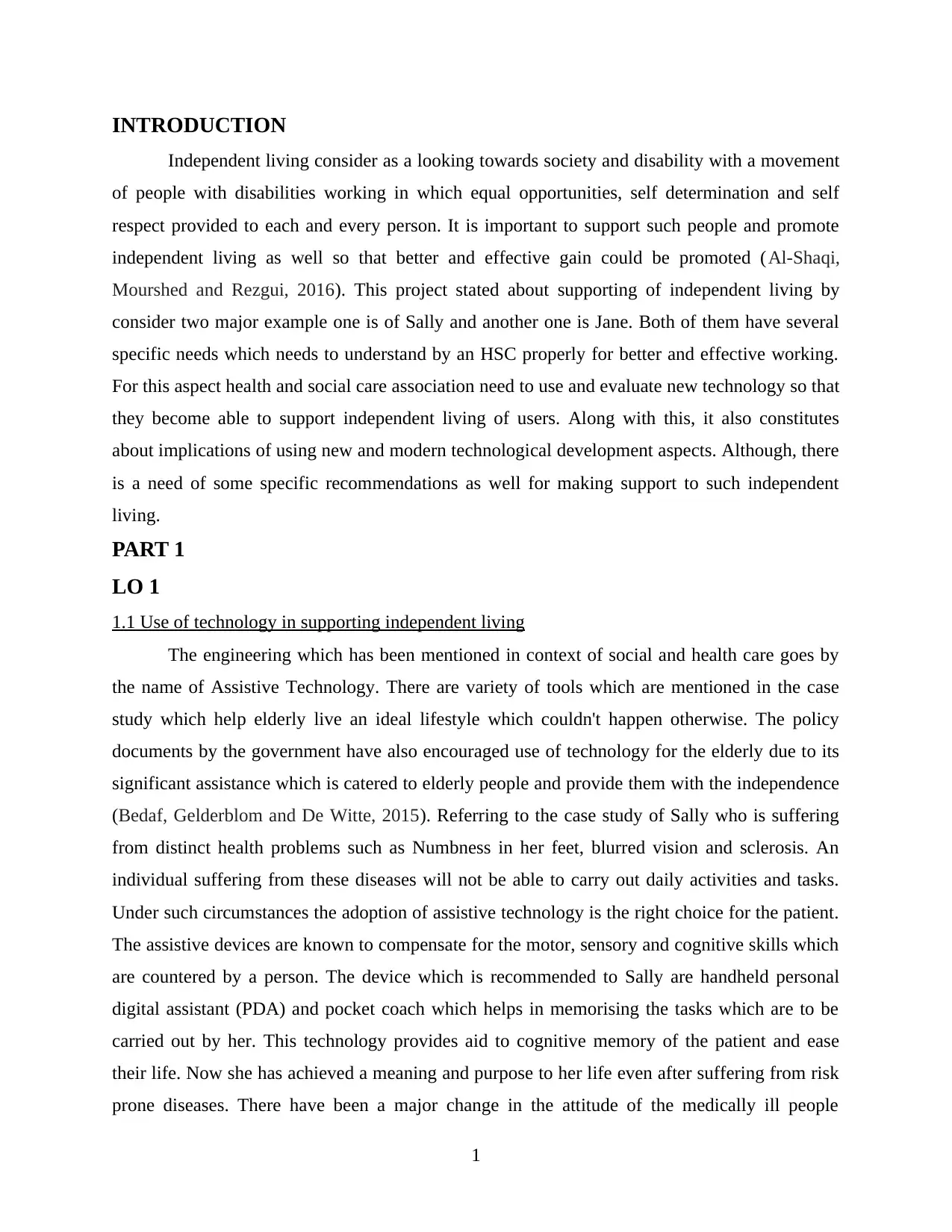
INTRODUCTION
Independent living consider as a looking towards society and disability with a movement
of people with disabilities working in which equal opportunities, self determination and self
respect provided to each and every person. It is important to support such people and promote
independent living as well so that better and effective gain could be promoted (Al-Shaqi,
Mourshed and Rezgui, 2016). This project stated about supporting of independent living by
consider two major example one is of Sally and another one is Jane. Both of them have several
specific needs which needs to understand by an HSC properly for better and effective working.
For this aspect health and social care association need to use and evaluate new technology so that
they become able to support independent living of users. Along with this, it also constitutes
about implications of using new and modern technological development aspects. Although, there
is a need of some specific recommendations as well for making support to such independent
living.
PART 1
LO 1
1.1 Use of technology in supporting independent living
The engineering which has been mentioned in context of social and health care goes by
the name of Assistive Technology. There are variety of tools which are mentioned in the case
study which help elderly live an ideal lifestyle which couldn't happen otherwise. The policy
documents by the government have also encouraged use of technology for the elderly due to its
significant assistance which is catered to elderly people and provide them with the independence
(Bedaf, Gelderblom and De Witte, 2015). Referring to the case study of Sally who is suffering
from distinct health problems such as Numbness in her feet, blurred vision and sclerosis. An
individual suffering from these diseases will not be able to carry out daily activities and tasks.
Under such circumstances the adoption of assistive technology is the right choice for the patient.
The assistive devices are known to compensate for the motor, sensory and cognitive skills which
are countered by a person. The device which is recommended to Sally are handheld personal
digital assistant (PDA) and pocket coach which helps in memorising the tasks which are to be
carried out by her. This technology provides aid to cognitive memory of the patient and ease
their life. Now she has achieved a meaning and purpose to her life even after suffering from risk
prone diseases. There have been a major change in the attitude of the medically ill people
1
Independent living consider as a looking towards society and disability with a movement
of people with disabilities working in which equal opportunities, self determination and self
respect provided to each and every person. It is important to support such people and promote
independent living as well so that better and effective gain could be promoted (Al-Shaqi,
Mourshed and Rezgui, 2016). This project stated about supporting of independent living by
consider two major example one is of Sally and another one is Jane. Both of them have several
specific needs which needs to understand by an HSC properly for better and effective working.
For this aspect health and social care association need to use and evaluate new technology so that
they become able to support independent living of users. Along with this, it also constitutes
about implications of using new and modern technological development aspects. Although, there
is a need of some specific recommendations as well for making support to such independent
living.
PART 1
LO 1
1.1 Use of technology in supporting independent living
The engineering which has been mentioned in context of social and health care goes by
the name of Assistive Technology. There are variety of tools which are mentioned in the case
study which help elderly live an ideal lifestyle which couldn't happen otherwise. The policy
documents by the government have also encouraged use of technology for the elderly due to its
significant assistance which is catered to elderly people and provide them with the independence
(Bedaf, Gelderblom and De Witte, 2015). Referring to the case study of Sally who is suffering
from distinct health problems such as Numbness in her feet, blurred vision and sclerosis. An
individual suffering from these diseases will not be able to carry out daily activities and tasks.
Under such circumstances the adoption of assistive technology is the right choice for the patient.
The assistive devices are known to compensate for the motor, sensory and cognitive skills which
are countered by a person. The device which is recommended to Sally are handheld personal
digital assistant (PDA) and pocket coach which helps in memorising the tasks which are to be
carried out by her. This technology provides aid to cognitive memory of the patient and ease
their life. Now she has achieved a meaning and purpose to her life even after suffering from risk
prone diseases. There have been a major change in the attitude of the medically ill people
1
⊘ This is a preview!⊘
Do you want full access?
Subscribe today to unlock all pages.

Trusted by 1+ million students worldwide
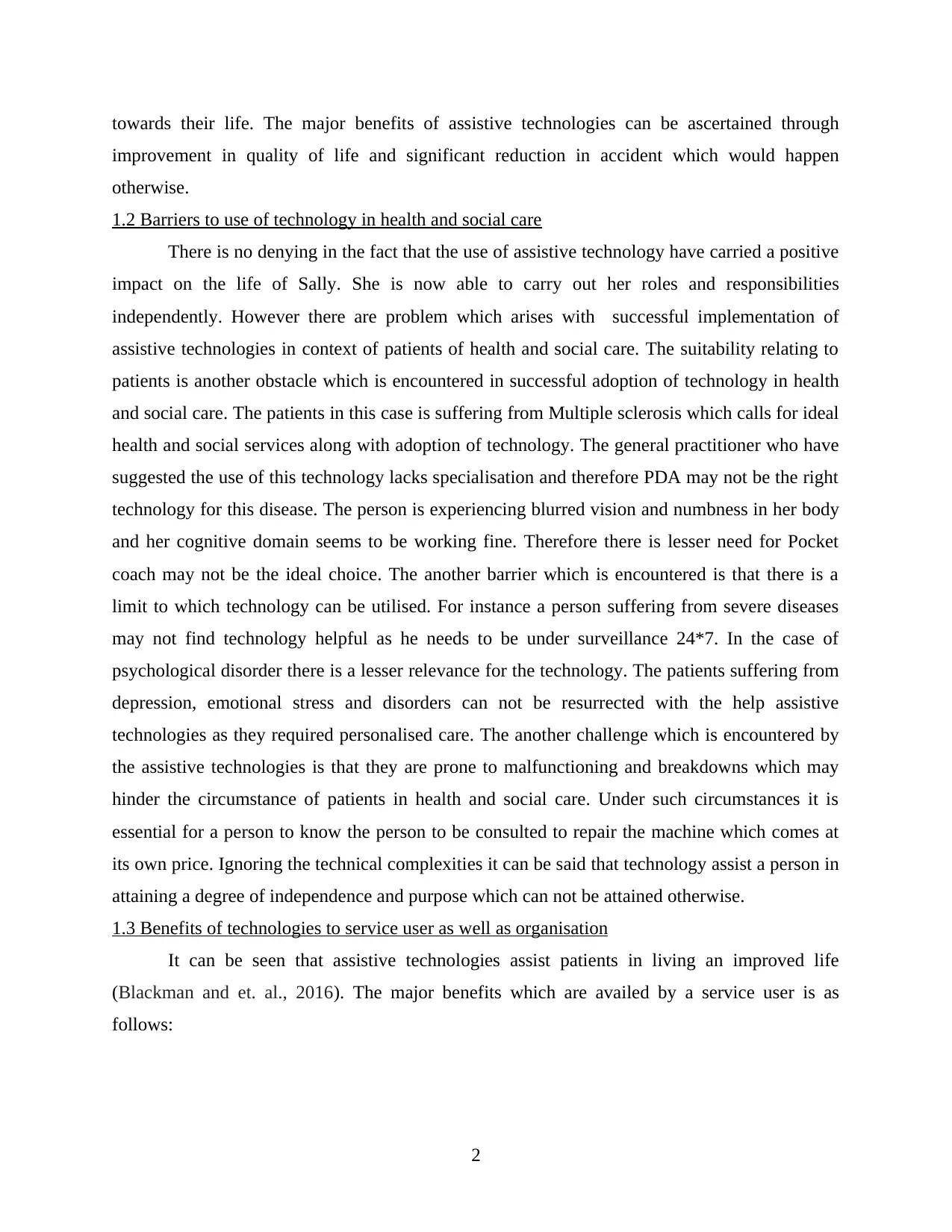
towards their life. The major benefits of assistive technologies can be ascertained through
improvement in quality of life and significant reduction in accident which would happen
otherwise.
1.2 Barriers to use of technology in health and social care
There is no denying in the fact that the use of assistive technology have carried a positive
impact on the life of Sally. She is now able to carry out her roles and responsibilities
independently. However there are problem which arises with successful implementation of
assistive technologies in context of patients of health and social care. The suitability relating to
patients is another obstacle which is encountered in successful adoption of technology in health
and social care. The patients in this case is suffering from Multiple sclerosis which calls for ideal
health and social services along with adoption of technology. The general practitioner who have
suggested the use of this technology lacks specialisation and therefore PDA may not be the right
technology for this disease. The person is experiencing blurred vision and numbness in her body
and her cognitive domain seems to be working fine. Therefore there is lesser need for Pocket
coach may not be the ideal choice. The another barrier which is encountered is that there is a
limit to which technology can be utilised. For instance a person suffering from severe diseases
may not find technology helpful as he needs to be under surveillance 24*7. In the case of
psychological disorder there is a lesser relevance for the technology. The patients suffering from
depression, emotional stress and disorders can not be resurrected with the help assistive
technologies as they required personalised care. The another challenge which is encountered by
the assistive technologies is that they are prone to malfunctioning and breakdowns which may
hinder the circumstance of patients in health and social care. Under such circumstances it is
essential for a person to know the person to be consulted to repair the machine which comes at
its own price. Ignoring the technical complexities it can be said that technology assist a person in
attaining a degree of independence and purpose which can not be attained otherwise.
1.3 Benefits of technologies to service user as well as organisation
It can be seen that assistive technologies assist patients in living an improved life
(Blackman and et. al., 2016). The major benefits which are availed by a service user is as
follows:
2
improvement in quality of life and significant reduction in accident which would happen
otherwise.
1.2 Barriers to use of technology in health and social care
There is no denying in the fact that the use of assistive technology have carried a positive
impact on the life of Sally. She is now able to carry out her roles and responsibilities
independently. However there are problem which arises with successful implementation of
assistive technologies in context of patients of health and social care. The suitability relating to
patients is another obstacle which is encountered in successful adoption of technology in health
and social care. The patients in this case is suffering from Multiple sclerosis which calls for ideal
health and social services along with adoption of technology. The general practitioner who have
suggested the use of this technology lacks specialisation and therefore PDA may not be the right
technology for this disease. The person is experiencing blurred vision and numbness in her body
and her cognitive domain seems to be working fine. Therefore there is lesser need for Pocket
coach may not be the ideal choice. The another barrier which is encountered is that there is a
limit to which technology can be utilised. For instance a person suffering from severe diseases
may not find technology helpful as he needs to be under surveillance 24*7. In the case of
psychological disorder there is a lesser relevance for the technology. The patients suffering from
depression, emotional stress and disorders can not be resurrected with the help assistive
technologies as they required personalised care. The another challenge which is encountered by
the assistive technologies is that they are prone to malfunctioning and breakdowns which may
hinder the circumstance of patients in health and social care. Under such circumstances it is
essential for a person to know the person to be consulted to repair the machine which comes at
its own price. Ignoring the technical complexities it can be said that technology assist a person in
attaining a degree of independence and purpose which can not be attained otherwise.
1.3 Benefits of technologies to service user as well as organisation
It can be seen that assistive technologies assist patients in living an improved life
(Blackman and et. al., 2016). The major benefits which are availed by a service user is as
follows:
2
Paraphrase This Document
Need a fresh take? Get an instant paraphrase of this document with our AI Paraphraser
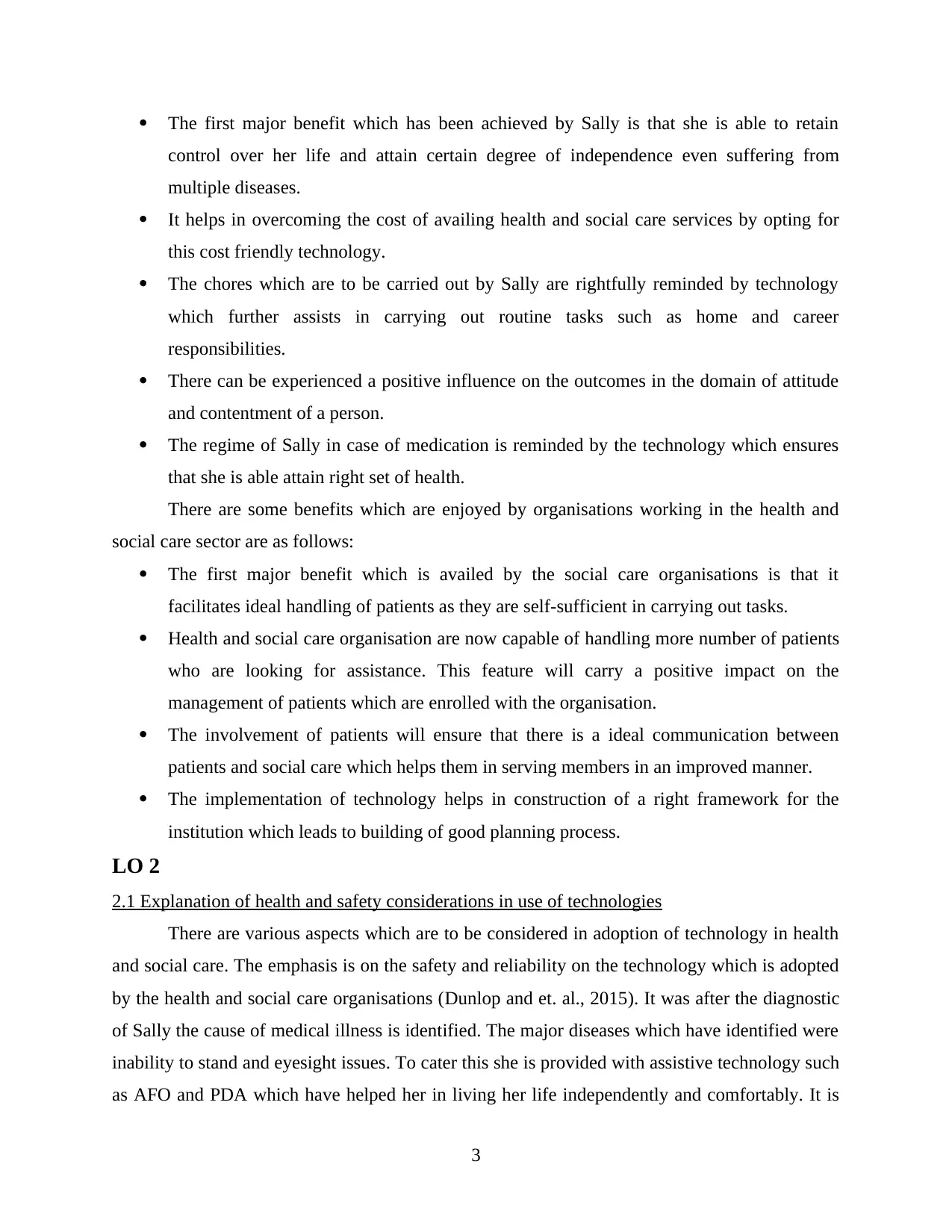
The first major benefit which has been achieved by Sally is that she is able to retain
control over her life and attain certain degree of independence even suffering from
multiple diseases.
It helps in overcoming the cost of availing health and social care services by opting for
this cost friendly technology.
The chores which are to be carried out by Sally are rightfully reminded by technology
which further assists in carrying out routine tasks such as home and career
responsibilities.
There can be experienced a positive influence on the outcomes in the domain of attitude
and contentment of a person.
The regime of Sally in case of medication is reminded by the technology which ensures
that she is able attain right set of health.
There are some benefits which are enjoyed by organisations working in the health and
social care sector are as follows:
The first major benefit which is availed by the social care organisations is that it
facilitates ideal handling of patients as they are self-sufficient in carrying out tasks.
Health and social care organisation are now capable of handling more number of patients
who are looking for assistance. This feature will carry a positive impact on the
management of patients which are enrolled with the organisation.
The involvement of patients will ensure that there is a ideal communication between
patients and social care which helps them in serving members in an improved manner.
The implementation of technology helps in construction of a right framework for the
institution which leads to building of good planning process.
LO 2
2.1 Explanation of health and safety considerations in use of technologies
There are various aspects which are to be considered in adoption of technology in health
and social care. The emphasis is on the safety and reliability on the technology which is adopted
by the health and social care organisations (Dunlop and et. al., 2015). It was after the diagnostic
of Sally the cause of medical illness is identified. The major diseases which have identified were
inability to stand and eyesight issues. To cater this she is provided with assistive technology such
as AFO and PDA which have helped her in living her life independently and comfortably. It is
3
control over her life and attain certain degree of independence even suffering from
multiple diseases.
It helps in overcoming the cost of availing health and social care services by opting for
this cost friendly technology.
The chores which are to be carried out by Sally are rightfully reminded by technology
which further assists in carrying out routine tasks such as home and career
responsibilities.
There can be experienced a positive influence on the outcomes in the domain of attitude
and contentment of a person.
The regime of Sally in case of medication is reminded by the technology which ensures
that she is able attain right set of health.
There are some benefits which are enjoyed by organisations working in the health and
social care sector are as follows:
The first major benefit which is availed by the social care organisations is that it
facilitates ideal handling of patients as they are self-sufficient in carrying out tasks.
Health and social care organisation are now capable of handling more number of patients
who are looking for assistance. This feature will carry a positive impact on the
management of patients which are enrolled with the organisation.
The involvement of patients will ensure that there is a ideal communication between
patients and social care which helps them in serving members in an improved manner.
The implementation of technology helps in construction of a right framework for the
institution which leads to building of good planning process.
LO 2
2.1 Explanation of health and safety considerations in use of technologies
There are various aspects which are to be considered in adoption of technology in health
and social care. The emphasis is on the safety and reliability on the technology which is adopted
by the health and social care organisations (Dunlop and et. al., 2015). It was after the diagnostic
of Sally the cause of medical illness is identified. The major diseases which have identified were
inability to stand and eyesight issues. To cater this she is provided with assistive technology such
as AFO and PDA which have helped her in living her life independently and comfortably. It is
3
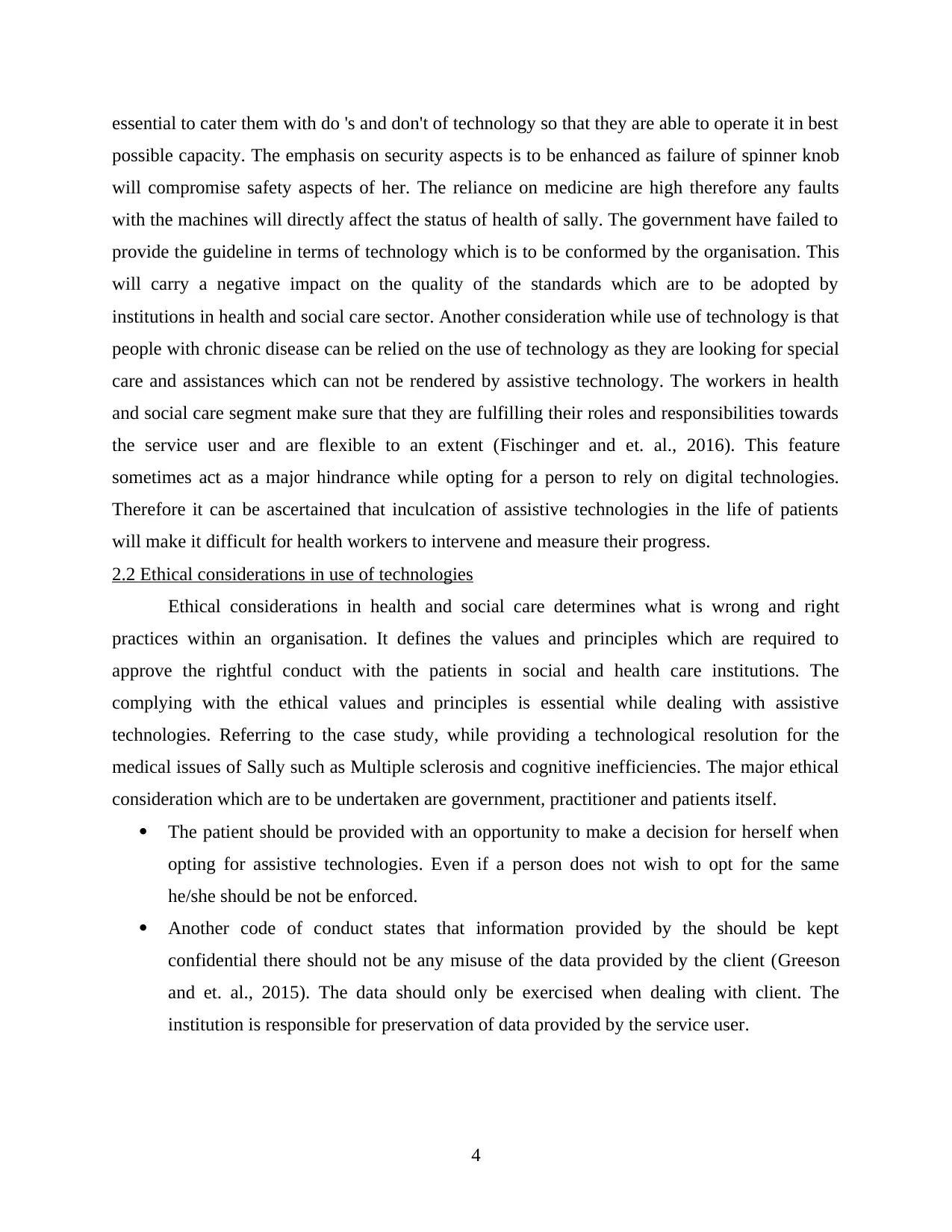
essential to cater them with do 's and don't of technology so that they are able to operate it in best
possible capacity. The emphasis on security aspects is to be enhanced as failure of spinner knob
will compromise safety aspects of her. The reliance on medicine are high therefore any faults
with the machines will directly affect the status of health of sally. The government have failed to
provide the guideline in terms of technology which is to be conformed by the organisation. This
will carry a negative impact on the quality of the standards which are to be adopted by
institutions in health and social care sector. Another consideration while use of technology is that
people with chronic disease can be relied on the use of technology as they are looking for special
care and assistances which can not be rendered by assistive technology. The workers in health
and social care segment make sure that they are fulfilling their roles and responsibilities towards
the service user and are flexible to an extent (Fischinger and et. al., 2016). This feature
sometimes act as a major hindrance while opting for a person to rely on digital technologies.
Therefore it can be ascertained that inculcation of assistive technologies in the life of patients
will make it difficult for health workers to intervene and measure their progress.
2.2 Ethical considerations in use of technologies
Ethical considerations in health and social care determines what is wrong and right
practices within an organisation. It defines the values and principles which are required to
approve the rightful conduct with the patients in social and health care institutions. The
complying with the ethical values and principles is essential while dealing with assistive
technologies. Referring to the case study, while providing a technological resolution for the
medical issues of Sally such as Multiple sclerosis and cognitive inefficiencies. The major ethical
consideration which are to be undertaken are government, practitioner and patients itself.
The patient should be provided with an opportunity to make a decision for herself when
opting for assistive technologies. Even if a person does not wish to opt for the same
he/she should be not be enforced.
Another code of conduct states that information provided by the should be kept
confidential there should not be any misuse of the data provided by the client (Greeson
and et. al., 2015). The data should only be exercised when dealing with client. The
institution is responsible for preservation of data provided by the service user.
4
possible capacity. The emphasis on security aspects is to be enhanced as failure of spinner knob
will compromise safety aspects of her. The reliance on medicine are high therefore any faults
with the machines will directly affect the status of health of sally. The government have failed to
provide the guideline in terms of technology which is to be conformed by the organisation. This
will carry a negative impact on the quality of the standards which are to be adopted by
institutions in health and social care sector. Another consideration while use of technology is that
people with chronic disease can be relied on the use of technology as they are looking for special
care and assistances which can not be rendered by assistive technology. The workers in health
and social care segment make sure that they are fulfilling their roles and responsibilities towards
the service user and are flexible to an extent (Fischinger and et. al., 2016). This feature
sometimes act as a major hindrance while opting for a person to rely on digital technologies.
Therefore it can be ascertained that inculcation of assistive technologies in the life of patients
will make it difficult for health workers to intervene and measure their progress.
2.2 Ethical considerations in use of technologies
Ethical considerations in health and social care determines what is wrong and right
practices within an organisation. It defines the values and principles which are required to
approve the rightful conduct with the patients in social and health care institutions. The
complying with the ethical values and principles is essential while dealing with assistive
technologies. Referring to the case study, while providing a technological resolution for the
medical issues of Sally such as Multiple sclerosis and cognitive inefficiencies. The major ethical
consideration which are to be undertaken are government, practitioner and patients itself.
The patient should be provided with an opportunity to make a decision for herself when
opting for assistive technologies. Even if a person does not wish to opt for the same
he/she should be not be enforced.
Another code of conduct states that information provided by the should be kept
confidential there should not be any misuse of the data provided by the client (Greeson
and et. al., 2015). The data should only be exercised when dealing with client. The
institution is responsible for preservation of data provided by the service user.
4
⊘ This is a preview!⊘
Do you want full access?
Subscribe today to unlock all pages.

Trusted by 1+ million students worldwide
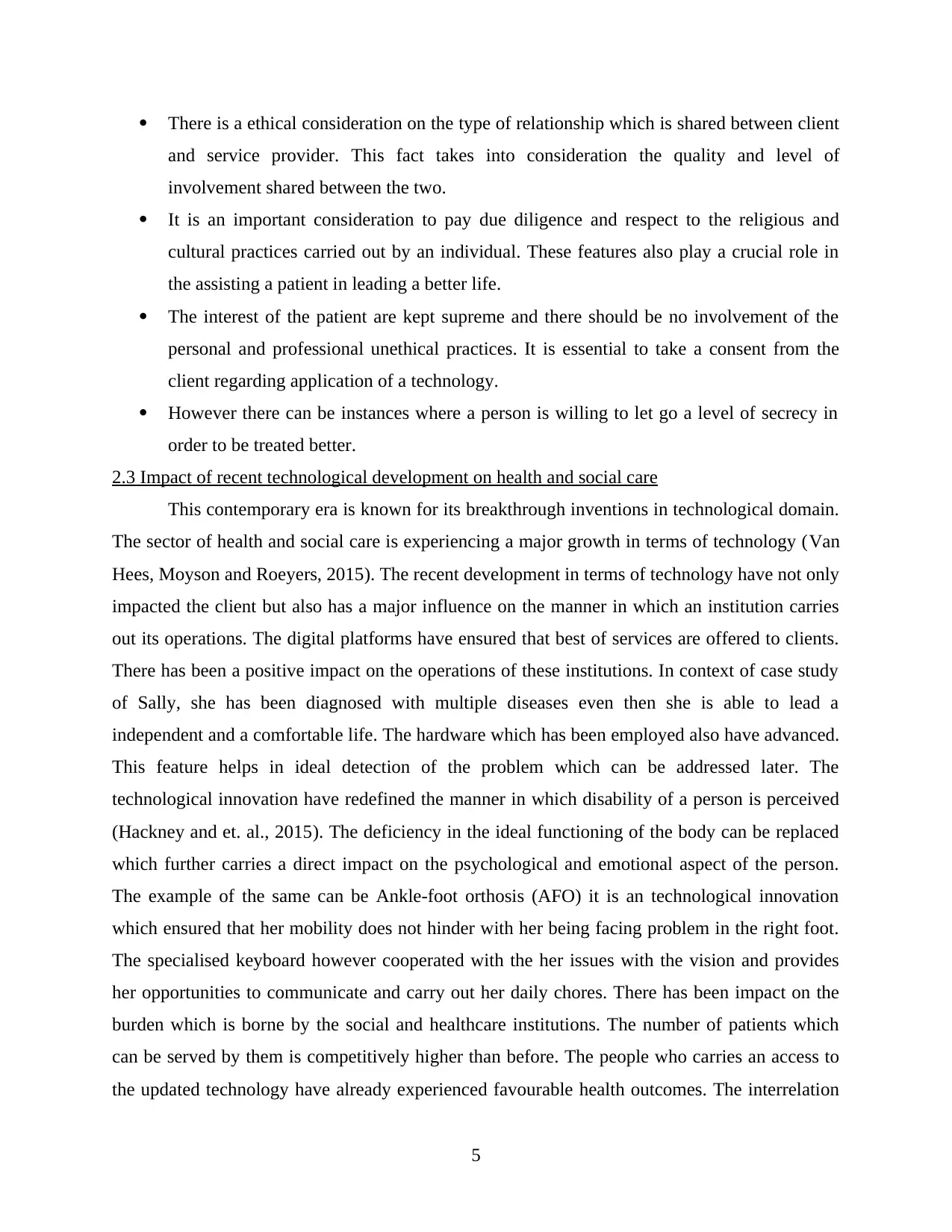
There is a ethical consideration on the type of relationship which is shared between client
and service provider. This fact takes into consideration the quality and level of
involvement shared between the two.
It is an important consideration to pay due diligence and respect to the religious and
cultural practices carried out by an individual. These features also play a crucial role in
the assisting a patient in leading a better life.
The interest of the patient are kept supreme and there should be no involvement of the
personal and professional unethical practices. It is essential to take a consent from the
client regarding application of a technology.
However there can be instances where a person is willing to let go a level of secrecy in
order to be treated better.
2.3 Impact of recent technological development on health and social care
This contemporary era is known for its breakthrough inventions in technological domain.
The sector of health and social care is experiencing a major growth in terms of technology (Van
Hees, Moyson and Roeyers, 2015). The recent development in terms of technology have not only
impacted the client but also has a major influence on the manner in which an institution carries
out its operations. The digital platforms have ensured that best of services are offered to clients.
There has been a positive impact on the operations of these institutions. In context of case study
of Sally, she has been diagnosed with multiple diseases even then she is able to lead a
independent and a comfortable life. The hardware which has been employed also have advanced.
This feature helps in ideal detection of the problem which can be addressed later. The
technological innovation have redefined the manner in which disability of a person is perceived
(Hackney and et. al., 2015). The deficiency in the ideal functioning of the body can be replaced
which further carries a direct impact on the psychological and emotional aspect of the person.
The example of the same can be Ankle-foot orthosis (AFO) it is an technological innovation
which ensured that her mobility does not hinder with her being facing problem in the right foot.
The specialised keyboard however cooperated with the her issues with the vision and provides
her opportunities to communicate and carry out her daily chores. There has been impact on the
burden which is borne by the social and healthcare institutions. The number of patients which
can be served by them is competitively higher than before. The people who carries an access to
the updated technology have already experienced favourable health outcomes. The interrelation
5
and service provider. This fact takes into consideration the quality and level of
involvement shared between the two.
It is an important consideration to pay due diligence and respect to the religious and
cultural practices carried out by an individual. These features also play a crucial role in
the assisting a patient in leading a better life.
The interest of the patient are kept supreme and there should be no involvement of the
personal and professional unethical practices. It is essential to take a consent from the
client regarding application of a technology.
However there can be instances where a person is willing to let go a level of secrecy in
order to be treated better.
2.3 Impact of recent technological development on health and social care
This contemporary era is known for its breakthrough inventions in technological domain.
The sector of health and social care is experiencing a major growth in terms of technology (Van
Hees, Moyson and Roeyers, 2015). The recent development in terms of technology have not only
impacted the client but also has a major influence on the manner in which an institution carries
out its operations. The digital platforms have ensured that best of services are offered to clients.
There has been a positive impact on the operations of these institutions. In context of case study
of Sally, she has been diagnosed with multiple diseases even then she is able to lead a
independent and a comfortable life. The hardware which has been employed also have advanced.
This feature helps in ideal detection of the problem which can be addressed later. The
technological innovation have redefined the manner in which disability of a person is perceived
(Hackney and et. al., 2015). The deficiency in the ideal functioning of the body can be replaced
which further carries a direct impact on the psychological and emotional aspect of the person.
The example of the same can be Ankle-foot orthosis (AFO) it is an technological innovation
which ensured that her mobility does not hinder with her being facing problem in the right foot.
The specialised keyboard however cooperated with the her issues with the vision and provides
her opportunities to communicate and carry out her daily chores. There has been impact on the
burden which is borne by the social and healthcare institutions. The number of patients which
can be served by them is competitively higher than before. The people who carries an access to
the updated technology have already experienced favourable health outcomes. The interrelation
5
Paraphrase This Document
Need a fresh take? Get an instant paraphrase of this document with our AI Paraphraser
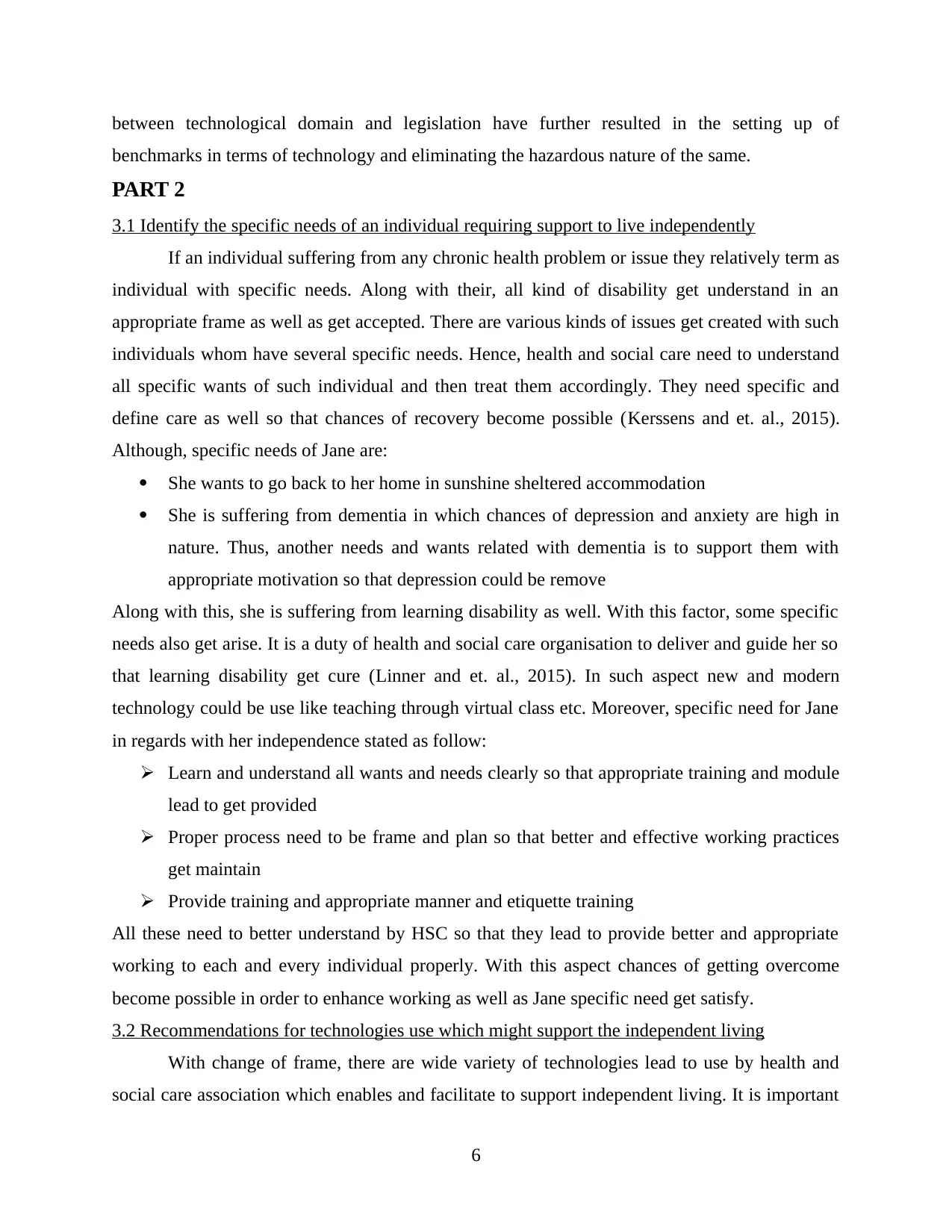
between technological domain and legislation have further resulted in the setting up of
benchmarks in terms of technology and eliminating the hazardous nature of the same.
PART 2
3.1 Identify the specific needs of an individual requiring support to live independently
If an individual suffering from any chronic health problem or issue they relatively term as
individual with specific needs. Along with their, all kind of disability get understand in an
appropriate frame as well as get accepted. There are various kinds of issues get created with such
individuals whom have several specific needs. Hence, health and social care need to understand
all specific wants of such individual and then treat them accordingly. They need specific and
define care as well so that chances of recovery become possible (Kerssens and et. al., 2015).
Although, specific needs of Jane are:
She wants to go back to her home in sunshine sheltered accommodation
She is suffering from dementia in which chances of depression and anxiety are high in
nature. Thus, another needs and wants related with dementia is to support them with
appropriate motivation so that depression could be remove
Along with this, she is suffering from learning disability as well. With this factor, some specific
needs also get arise. It is a duty of health and social care organisation to deliver and guide her so
that learning disability get cure (Linner and et. al., 2015). In such aspect new and modern
technology could be use like teaching through virtual class etc. Moreover, specific need for Jane
in regards with her independence stated as follow:
Learn and understand all wants and needs clearly so that appropriate training and module
lead to get provided
Proper process need to be frame and plan so that better and effective working practices
get maintain
Provide training and appropriate manner and etiquette training
All these need to better understand by HSC so that they lead to provide better and appropriate
working to each and every individual properly. With this aspect chances of getting overcome
become possible in order to enhance working as well as Jane specific need get satisfy.
3.2 Recommendations for technologies use which might support the independent living
With change of frame, there are wide variety of technologies lead to use by health and
social care association which enables and facilitate to support independent living. It is important
6
benchmarks in terms of technology and eliminating the hazardous nature of the same.
PART 2
3.1 Identify the specific needs of an individual requiring support to live independently
If an individual suffering from any chronic health problem or issue they relatively term as
individual with specific needs. Along with their, all kind of disability get understand in an
appropriate frame as well as get accepted. There are various kinds of issues get created with such
individuals whom have several specific needs. Hence, health and social care need to understand
all specific wants of such individual and then treat them accordingly. They need specific and
define care as well so that chances of recovery become possible (Kerssens and et. al., 2015).
Although, specific needs of Jane are:
She wants to go back to her home in sunshine sheltered accommodation
She is suffering from dementia in which chances of depression and anxiety are high in
nature. Thus, another needs and wants related with dementia is to support them with
appropriate motivation so that depression could be remove
Along with this, she is suffering from learning disability as well. With this factor, some specific
needs also get arise. It is a duty of health and social care organisation to deliver and guide her so
that learning disability get cure (Linner and et. al., 2015). In such aspect new and modern
technology could be use like teaching through virtual class etc. Moreover, specific need for Jane
in regards with her independence stated as follow:
Learn and understand all wants and needs clearly so that appropriate training and module
lead to get provided
Proper process need to be frame and plan so that better and effective working practices
get maintain
Provide training and appropriate manner and etiquette training
All these need to better understand by HSC so that they lead to provide better and appropriate
working to each and every individual properly. With this aspect chances of getting overcome
become possible in order to enhance working as well as Jane specific need get satisfy.
3.2 Recommendations for technologies use which might support the independent living
With change of frame, there are wide variety of technologies lead to use by health and
social care association which enables and facilitate to support independent living. It is important
6
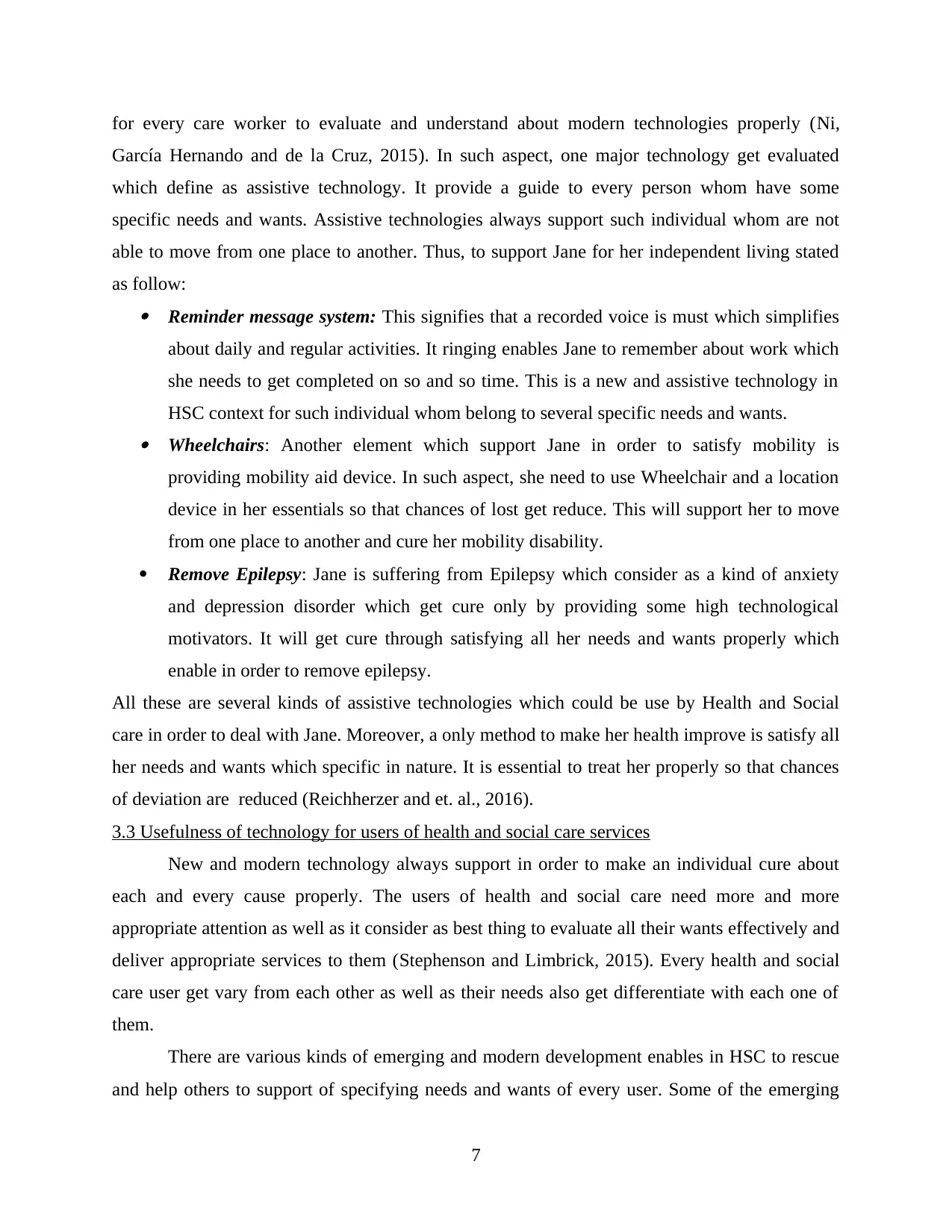
for every care worker to evaluate and understand about modern technologies properly (Ni,
García Hernando and de la Cruz, 2015). In such aspect, one major technology get evaluated
which define as assistive technology. It provide a guide to every person whom have some
specific needs and wants. Assistive technologies always support such individual whom are not
able to move from one place to another. Thus, to support Jane for her independent living stated
as follow: Reminder message system: This signifies that a recorded voice is must which simplifies
about daily and regular activities. It ringing enables Jane to remember about work which
she needs to get completed on so and so time. This is a new and assistive technology in
HSC context for such individual whom belong to several specific needs and wants. Wheelchairs: Another element which support Jane in order to satisfy mobility is
providing mobility aid device. In such aspect, she need to use Wheelchair and a location
device in her essentials so that chances of lost get reduce. This will support her to move
from one place to another and cure her mobility disability.
Remove Epilepsy: Jane is suffering from Epilepsy which consider as a kind of anxiety
and depression disorder which get cure only by providing some high technological
motivators. It will get cure through satisfying all her needs and wants properly which
enable in order to remove epilepsy.
All these are several kinds of assistive technologies which could be use by Health and Social
care in order to deal with Jane. Moreover, a only method to make her health improve is satisfy all
her needs and wants which specific in nature. It is essential to treat her properly so that chances
of deviation are reduced (Reichherzer and et. al., 2016).
3.3 Usefulness of technology for users of health and social care services
New and modern technology always support in order to make an individual cure about
each and every cause properly. The users of health and social care need more and more
appropriate attention as well as it consider as best thing to evaluate all their wants effectively and
deliver appropriate services to them (Stephenson and Limbrick, 2015). Every health and social
care user get vary from each other as well as their needs also get differentiate with each one of
them.
There are various kinds of emerging and modern development enables in HSC to rescue
and help others to support of specifying needs and wants of every user. Some of the emerging
7
García Hernando and de la Cruz, 2015). In such aspect, one major technology get evaluated
which define as assistive technology. It provide a guide to every person whom have some
specific needs and wants. Assistive technologies always support such individual whom are not
able to move from one place to another. Thus, to support Jane for her independent living stated
as follow: Reminder message system: This signifies that a recorded voice is must which simplifies
about daily and regular activities. It ringing enables Jane to remember about work which
she needs to get completed on so and so time. This is a new and assistive technology in
HSC context for such individual whom belong to several specific needs and wants. Wheelchairs: Another element which support Jane in order to satisfy mobility is
providing mobility aid device. In such aspect, she need to use Wheelchair and a location
device in her essentials so that chances of lost get reduce. This will support her to move
from one place to another and cure her mobility disability.
Remove Epilepsy: Jane is suffering from Epilepsy which consider as a kind of anxiety
and depression disorder which get cure only by providing some high technological
motivators. It will get cure through satisfying all her needs and wants properly which
enable in order to remove epilepsy.
All these are several kinds of assistive technologies which could be use by Health and Social
care in order to deal with Jane. Moreover, a only method to make her health improve is satisfy all
her needs and wants which specific in nature. It is essential to treat her properly so that chances
of deviation are reduced (Reichherzer and et. al., 2016).
3.3 Usefulness of technology for users of health and social care services
New and modern technology always support in order to make an individual cure about
each and every cause properly. The users of health and social care need more and more
appropriate attention as well as it consider as best thing to evaluate all their wants effectively and
deliver appropriate services to them (Stephenson and Limbrick, 2015). Every health and social
care user get vary from each other as well as their needs also get differentiate with each one of
them.
There are various kinds of emerging and modern development enables in HSC to rescue
and help others to support of specifying needs and wants of every user. Some of the emerging
7
⊘ This is a preview!⊘
Do you want full access?
Subscribe today to unlock all pages.

Trusted by 1+ million students worldwide
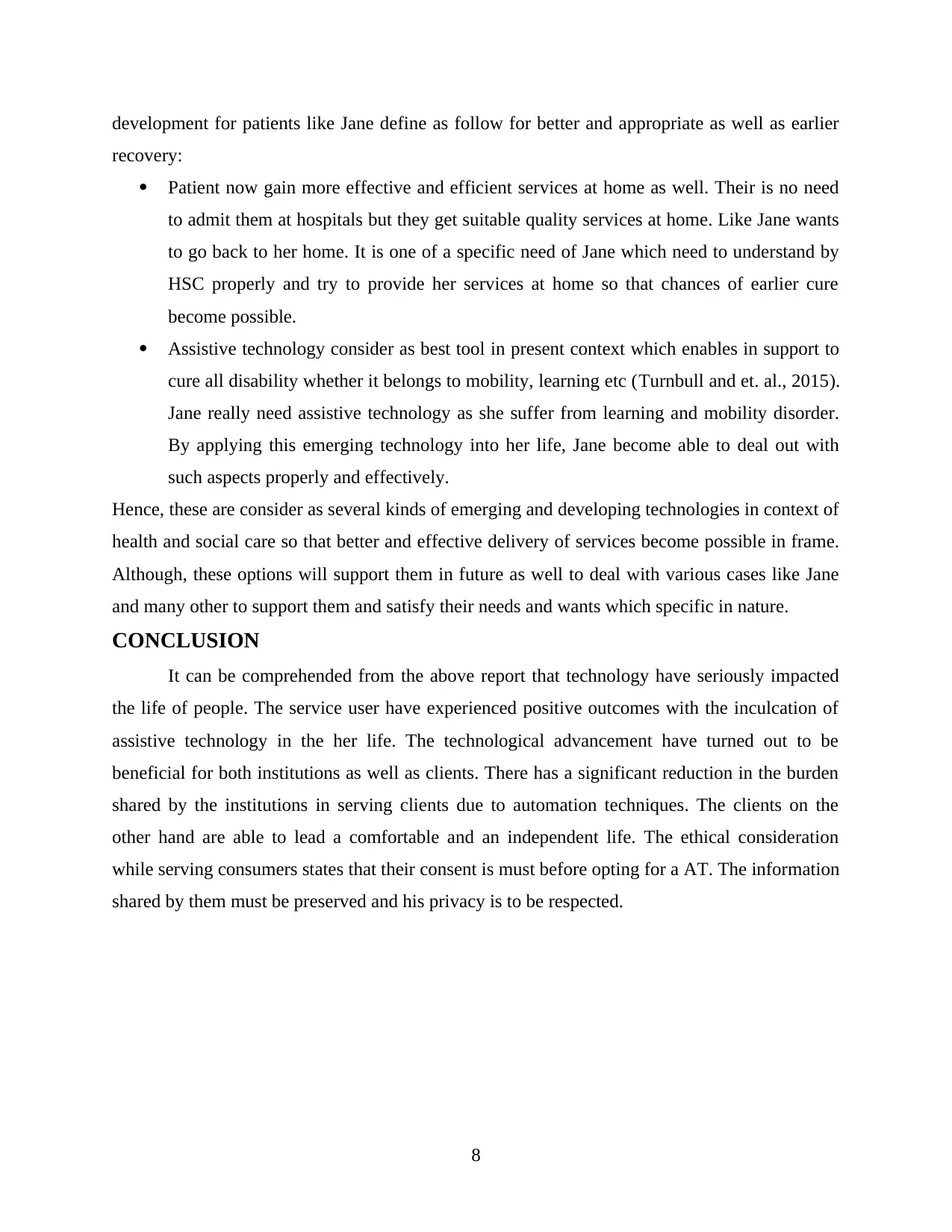
development for patients like Jane define as follow for better and appropriate as well as earlier
recovery:
Patient now gain more effective and efficient services at home as well. Their is no need
to admit them at hospitals but they get suitable quality services at home. Like Jane wants
to go back to her home. It is one of a specific need of Jane which need to understand by
HSC properly and try to provide her services at home so that chances of earlier cure
become possible.
Assistive technology consider as best tool in present context which enables in support to
cure all disability whether it belongs to mobility, learning etc (Turnbull and et. al., 2015).
Jane really need assistive technology as she suffer from learning and mobility disorder.
By applying this emerging technology into her life, Jane become able to deal out with
such aspects properly and effectively.
Hence, these are consider as several kinds of emerging and developing technologies in context of
health and social care so that better and effective delivery of services become possible in frame.
Although, these options will support them in future as well to deal with various cases like Jane
and many other to support them and satisfy their needs and wants which specific in nature.
CONCLUSION
It can be comprehended from the above report that technology have seriously impacted
the life of people. The service user have experienced positive outcomes with the inculcation of
assistive technology in the her life. The technological advancement have turned out to be
beneficial for both institutions as well as clients. There has a significant reduction in the burden
shared by the institutions in serving clients due to automation techniques. The clients on the
other hand are able to lead a comfortable and an independent life. The ethical consideration
while serving consumers states that their consent is must before opting for a AT. The information
shared by them must be preserved and his privacy is to be respected.
8
recovery:
Patient now gain more effective and efficient services at home as well. Their is no need
to admit them at hospitals but they get suitable quality services at home. Like Jane wants
to go back to her home. It is one of a specific need of Jane which need to understand by
HSC properly and try to provide her services at home so that chances of earlier cure
become possible.
Assistive technology consider as best tool in present context which enables in support to
cure all disability whether it belongs to mobility, learning etc (Turnbull and et. al., 2015).
Jane really need assistive technology as she suffer from learning and mobility disorder.
By applying this emerging technology into her life, Jane become able to deal out with
such aspects properly and effectively.
Hence, these are consider as several kinds of emerging and developing technologies in context of
health and social care so that better and effective delivery of services become possible in frame.
Although, these options will support them in future as well to deal with various cases like Jane
and many other to support them and satisfy their needs and wants which specific in nature.
CONCLUSION
It can be comprehended from the above report that technology have seriously impacted
the life of people. The service user have experienced positive outcomes with the inculcation of
assistive technology in the her life. The technological advancement have turned out to be
beneficial for both institutions as well as clients. There has a significant reduction in the burden
shared by the institutions in serving clients due to automation techniques. The clients on the
other hand are able to lead a comfortable and an independent life. The ethical consideration
while serving consumers states that their consent is must before opting for a AT. The information
shared by them must be preserved and his privacy is to be respected.
8
Paraphrase This Document
Need a fresh take? Get an instant paraphrase of this document with our AI Paraphraser
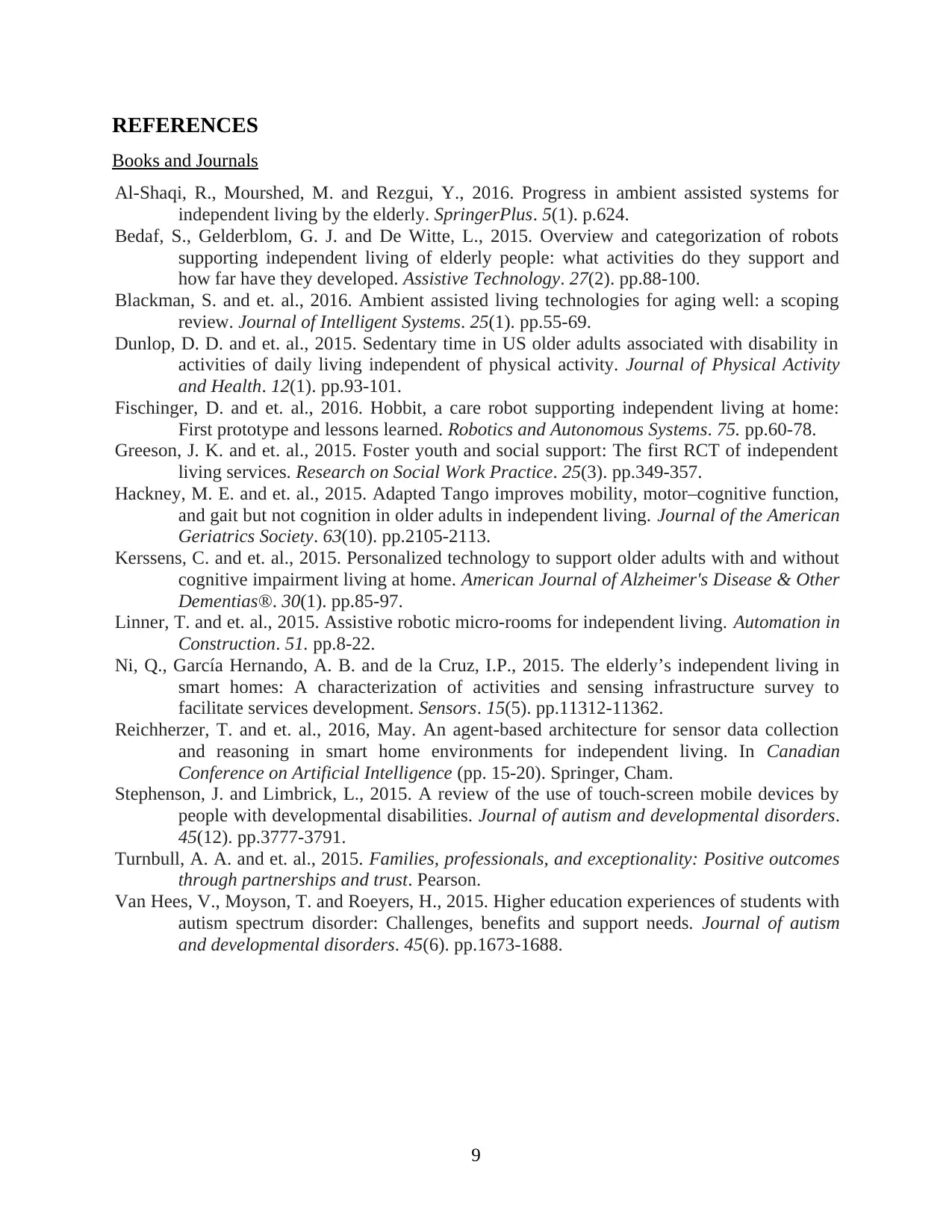
REFERENCES
Books and Journals
Al-Shaqi, R., Mourshed, M. and Rezgui, Y., 2016. Progress in ambient assisted systems for
independent living by the elderly. SpringerPlus. 5(1). p.624.
Bedaf, S., Gelderblom, G. J. and De Witte, L., 2015. Overview and categorization of robots
supporting independent living of elderly people: what activities do they support and
how far have they developed. Assistive Technology. 27(2). pp.88-100.
Blackman, S. and et. al., 2016. Ambient assisted living technologies for aging well: a scoping
review. Journal of Intelligent Systems. 25(1). pp.55-69.
Dunlop, D. D. and et. al., 2015. Sedentary time in US older adults associated with disability in
activities of daily living independent of physical activity. Journal of Physical Activity
and Health. 12(1). pp.93-101.
Fischinger, D. and et. al., 2016. Hobbit, a care robot supporting independent living at home:
First prototype and lessons learned. Robotics and Autonomous Systems. 75. pp.60-78.
Greeson, J. K. and et. al., 2015. Foster youth and social support: The first RCT of independent
living services. Research on Social Work Practice. 25(3). pp.349-357.
Hackney, M. E. and et. al., 2015. Adapted Tango improves mobility, motor–cognitive function,
and gait but not cognition in older adults in independent living. Journal of the American
Geriatrics Society. 63(10). pp.2105-2113.
Kerssens, C. and et. al., 2015. Personalized technology to support older adults with and without
cognitive impairment living at home. American Journal of Alzheimer's Disease & Other
Dementias®. 30(1). pp.85-97.
Linner, T. and et. al., 2015. Assistive robotic micro-rooms for independent living. Automation in
Construction. 51. pp.8-22.
Ni, Q., García Hernando, A. B. and de la Cruz, I.P., 2015. The elderly’s independent living in
smart homes: A characterization of activities and sensing infrastructure survey to
facilitate services development. Sensors. 15(5). pp.11312-11362.
Reichherzer, T. and et. al., 2016, May. An agent-based architecture for sensor data collection
and reasoning in smart home environments for independent living. In Canadian
Conference on Artificial Intelligence (pp. 15-20). Springer, Cham.
Stephenson, J. and Limbrick, L., 2015. A review of the use of touch-screen mobile devices by
people with developmental disabilities. Journal of autism and developmental disorders.
45(12). pp.3777-3791.
Turnbull, A. A. and et. al., 2015. Families, professionals, and exceptionality: Positive outcomes
through partnerships and trust. Pearson.
Van Hees, V., Moyson, T. and Roeyers, H., 2015. Higher education experiences of students with
autism spectrum disorder: Challenges, benefits and support needs. Journal of autism
and developmental disorders. 45(6). pp.1673-1688.
9
Books and Journals
Al-Shaqi, R., Mourshed, M. and Rezgui, Y., 2016. Progress in ambient assisted systems for
independent living by the elderly. SpringerPlus. 5(1). p.624.
Bedaf, S., Gelderblom, G. J. and De Witte, L., 2015. Overview and categorization of robots
supporting independent living of elderly people: what activities do they support and
how far have they developed. Assistive Technology. 27(2). pp.88-100.
Blackman, S. and et. al., 2016. Ambient assisted living technologies for aging well: a scoping
review. Journal of Intelligent Systems. 25(1). pp.55-69.
Dunlop, D. D. and et. al., 2015. Sedentary time in US older adults associated with disability in
activities of daily living independent of physical activity. Journal of Physical Activity
and Health. 12(1). pp.93-101.
Fischinger, D. and et. al., 2016. Hobbit, a care robot supporting independent living at home:
First prototype and lessons learned. Robotics and Autonomous Systems. 75. pp.60-78.
Greeson, J. K. and et. al., 2015. Foster youth and social support: The first RCT of independent
living services. Research on Social Work Practice. 25(3). pp.349-357.
Hackney, M. E. and et. al., 2015. Adapted Tango improves mobility, motor–cognitive function,
and gait but not cognition in older adults in independent living. Journal of the American
Geriatrics Society. 63(10). pp.2105-2113.
Kerssens, C. and et. al., 2015. Personalized technology to support older adults with and without
cognitive impairment living at home. American Journal of Alzheimer's Disease & Other
Dementias®. 30(1). pp.85-97.
Linner, T. and et. al., 2015. Assistive robotic micro-rooms for independent living. Automation in
Construction. 51. pp.8-22.
Ni, Q., García Hernando, A. B. and de la Cruz, I.P., 2015. The elderly’s independent living in
smart homes: A characterization of activities and sensing infrastructure survey to
facilitate services development. Sensors. 15(5). pp.11312-11362.
Reichherzer, T. and et. al., 2016, May. An agent-based architecture for sensor data collection
and reasoning in smart home environments for independent living. In Canadian
Conference on Artificial Intelligence (pp. 15-20). Springer, Cham.
Stephenson, J. and Limbrick, L., 2015. A review of the use of touch-screen mobile devices by
people with developmental disabilities. Journal of autism and developmental disorders.
45(12). pp.3777-3791.
Turnbull, A. A. and et. al., 2015. Families, professionals, and exceptionality: Positive outcomes
through partnerships and trust. Pearson.
Van Hees, V., Moyson, T. and Roeyers, H., 2015. Higher education experiences of students with
autism spectrum disorder: Challenges, benefits and support needs. Journal of autism
and developmental disorders. 45(6). pp.1673-1688.
9
1 out of 11
Related Documents
Your All-in-One AI-Powered Toolkit for Academic Success.
+13062052269
info@desklib.com
Available 24*7 on WhatsApp / Email
![[object Object]](/_next/static/media/star-bottom.7253800d.svg)
Unlock your academic potential
Copyright © 2020–2025 A2Z Services. All Rights Reserved. Developed and managed by ZUCOL.





